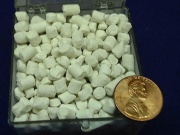Difference between revisions of "Lithium"
(username removed) |
|||
| Line 2: | Line 2: | ||
== Description == | == Description == | ||
| − | A soft, silvery metallic element. Lithium occurs naturally in the minerals [ | + | A soft, silvery metallic element. Lithium occurs naturally in the minerals [[spodumene]], [[lepidolite]], and [[petalite]] that is found in Canada, central Africa, Brazil, Argentina, Australia, Europe, and the United States. Lithium is also produced as a byproduct in the recovery of [[potash]] and [[borax]] from dry lake beds. Lithium was first discovered as a salt in 1817 by Johan A. Arfvedson and prepared as a pure metal by Davy the next year. Metallic lithium tarnishes rapidly in air and must by stored in a nonreactive liquid. Lithium is the lightest element in the alkali metal series. It is harder than metallic [[sodium]], but softer than [[lead]]. Metallic lithium is used as a heat transfer medium in nuclear reactors, as a deoxidizer and strengthener in many alloys and in the manufacture of high strength [[ceramic|ceramics]], [[enamel, inorganic|enamels]], and optical quality [[glass]]. |
== Synonyms and Related Terms == | == Synonyms and Related Terms == | ||
Revision as of 14:52, 21 January 2014
Description
A soft, silvery metallic element. Lithium occurs naturally in the minerals Spodumene, Lepidolite, and Petalite that is found in Canada, central Africa, Brazil, Argentina, Australia, Europe, and the United States. Lithium is also produced as a byproduct in the recovery of Potash and Borax from dry lake beds. Lithium was first discovered as a salt in 1817 by Johan A. Arfvedson and prepared as a pure metal by Davy the next year. Metallic lithium tarnishes rapidly in air and must by stored in a nonreactive liquid. Lithium is the lightest element in the alkali metal series. It is harder than metallic Sodium, but softer than Lead. Metallic lithium is used as a heat transfer medium in nuclear reactors, as a deoxidizer and strengthener in many alloys and in the manufacture of high strength ceramics, enamels, and optical quality Glass.
Synonyms and Related Terms
Li; litio (It., Port., Esp.); Litium (Sven.)
Other Properties
Flame color is deep red (670.8 nm). Reacts violently with inorganic acids.
Soluble in liquid ammonia.
| Composition | Li (atomic no. 3) |
|---|---|
| CAS | 7439-93-2 |
| Mohs Hardness | 0.6 |
| Melting Point | 180.54 |
| Density | 0.534 |
| Molecular Weight | atomic wt = 6.941 |
| Boiling Point | 1336 |
Hazards and Safety
Solutions containing lithium are toxic to the central nervous system.
Flammable. Lithium metal will ignite in air.
Fire and explosion risk when exposed to water, acids, or oxidizing agents.
Contact causes burns. Harmful by inhalation, ingestion and skin absorption.
International Chemical Safety Card
Additional Information
Web Elements: Website
Authority
- G.S.Brady, Materials Handbook, McGraw-Hill Book Co., New York, 1971
- Richard S. Lewis, Hawley's Condensed Chemical Dictionary, Van Nostrand Reinhold, New York, 10th ed., 1993
- Random House, Webster's Encyclopedic Unabridged Dictionary of the English Language, Grammercy Book, New York, 1997
- The Merck Index, Martha Windholz (ed.), Merck Research Labs, Rahway NJ, 10th edition, 1983 Comment: entry 5543
- The American Heritage Dictionary or Encarta, via Microsoft Bookshelf 98, Microsoft Corp., 1998
